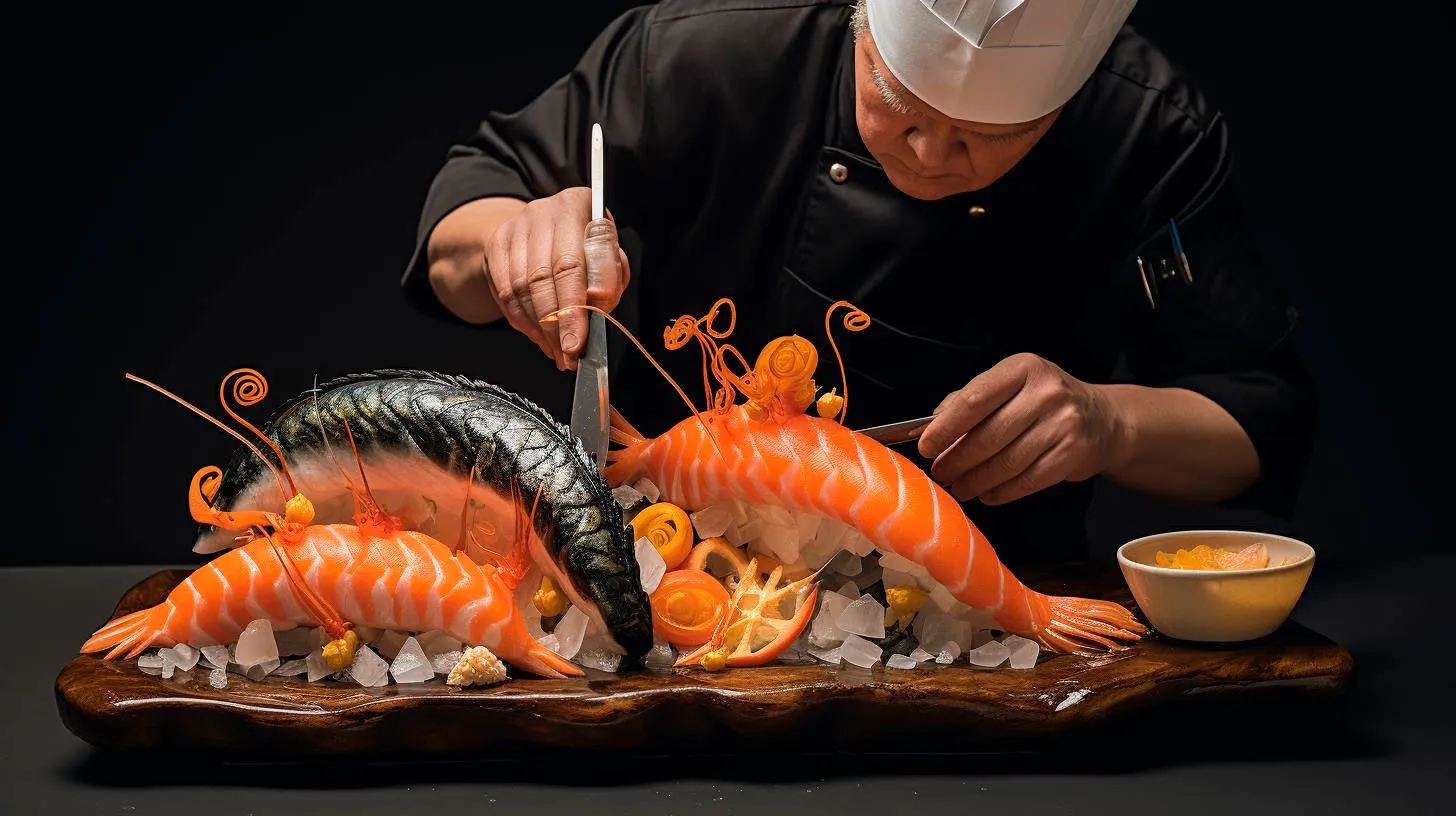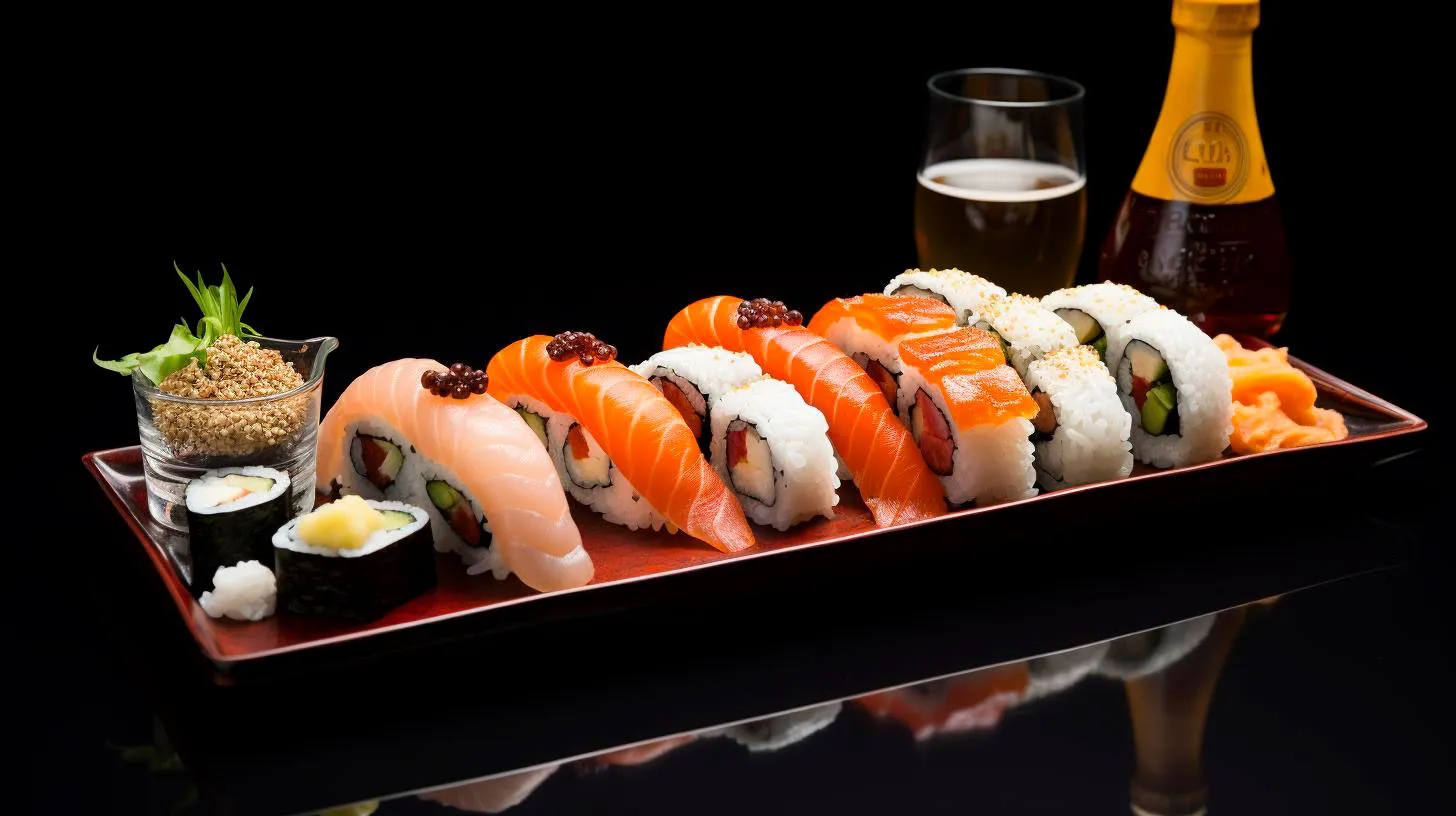Elevate Your Sushi Game: Insider Techniques for Optimal Roll Texture
Understanding the Importance of Roll Texture
Texture plays a crucial role in enhancing the overall sushi experience. While flavors are essential, the right texture can take your sushi roll from good to extraordinary. Here’s why texture matters:
- Mouthfeel: The texture of a sushi roll affects how it feels in your mouth. A well-crafted roll with a perfect balance of softness and firmness can create a satisfying and memorable dining experience.
- Biteability: The ability to bite through the roll with ease is crucial. No one wants to struggle to take a bite. Maintaining the right balance of ingredients and ensuring proper rolling techniques can contribute to a roll that’s easy to bite into.
- Visual Appeal: Texture also adds visual appeal, making your sushi roll more enticing. A roll with perfectly arranged ingredients and varying textures is visually appealing and can make your mouth water before you even take a bite.
Insider Techniques for Optimal Roll Texture
1. Cook Your Rice to Perfection
Start by using high-quality sushi rice and cook it properly. Cooking sushi rice to perfection ensures that it is sticky enough to hold the roll together. Overcooking or undercooking the rice can result in a less cohesive roll, affecting its texture. Here’s how to cook sushi rice:
- Rinse the rice several times until the water runs clear, removing excess starch.
- Use the appropriate amount of water for the rice-to-water ratio recommended for sushi rice. This ratio varies based on the specific type of rice.
- Cook the rice according to the instructions, ensuring that it’s not too mushy or undercooked.
- Once cooked, let the rice rest for a few minutes before using it for rolling sushi.
2. Proper Ingredient Preparation
The texture of each ingredient placed in the sushi roll is vital. Here are some key points to consider:
- Seafood and Vegetables: Cook seafood and vegetables properly to retain their firmness and texture. Overcooking can result in mushy fillings, which can negatively impact the texture of the roll.
- Cutting Techniques: Pay attention to how you cut the ingredients. Slicing seafood and vegetables into thin, uniform pieces promotes even distribution and maintains an optimal bite size.
- Seasoning: Season your ingredients appropriately to enhance their flavor, but be cautious not to over-season, as it can overpower the natural textures.
3. Proper Rolling Techniques
The way you roll your sushi impacts the texture and firmness of the final product. Follow these tips for optimal rolling:
- Tightness: Roll your sushi tightly to prevent it from falling apart. A tighter roll will result in a better texture, making it easier to handle and bite into.
- Even Distribution: Distribute the fillings evenly throughout the roll, ensuring consistent textures and flavors in each bite.
- Sealing: Seal the sushi roll properly to maintain the integrity of the roll and prevent any fillings from escaping during consumption.
Key Takeaways
Elevating your sushi game and achieving the perfect roll texture requires attention to detail and insider techniques:
- Texture plays a crucial role in enhancing the overall sushi experience, contributing to mouthfeel, biteability, and visual appeal.
- Cooking sushi rice to perfection is essential for achieving the right stickiness and cohesiveness in your rolls.
- Proper ingredient preparation, including cooking, cutting, and seasoning, ensures that each component retains its desired texture.
- Adopting proper rolling techniques, such as tightness, even distribution, and sealing, is vital for creating rolls with the perfect texture.
Remember, while texture is essential, don’t neglect other aspects of sushi-making, such as using fresh ingredients, experimenting with flavors, and presenting your rolls creatively. By combining these techniques, you’ll master the art of sushi and elevate your culinary skills to impress both yourself and your guests.
Unveiling the Secrets of Perfect Sushi Roll Consistency
The Importance of Sushi Roll Consistency
Sushi roll consistency is not just about aesthetics; it significantly affects the overall dining experience. Consistency ensures that each piece of sushi delivers a harmonious blend of flavors and textures. It also allows for more precise portion control, which is particularly important in commercial sushi establishments.
Furthermore, consistent sushi rolls are a reflection of the chef’s skill and attention to detail. Mastering the art of creating uniform sushi rolls elevates one’s culinary prowess, making them stand out in a competitive industry.
Secrets to Achieving Perfect Sushi Roll Consistency
1. Quality Ingredients
Good sushi starts with great ingredients. Ensure that you use the freshest seafood, vegetables, and rice available. Fresh ingredients not only enhance the flavors but also contribute to the consistency and texture of the sushi rolls. Invest in high-quality seafood and vegetables to make all the difference in your final product.
2. Precise Knife Skills
A sharp and well-maintained knife is an essential tool for creating consistent sushi rolls. Invest time in honing your knife skills to achieve precise and even cuts. By cutting the ingredients to the same size and shape, you ensure that each bite of sushi delivers a consistent experience.
3. Uniform Rice Distribution
Rice is the backbone of sushi rolls, and how it is distributed plays a significant role in their consistency. Spread a thin and even layer of rice across the nori (seaweed) sheet, leaving a small space at the top to seal the roll. Aim for consistency in the rice layer’s thickness to ensure even filling distribution and a seamless roll.
4. Proper Filling Placement
When placing the filling on the rice, make sure to distribute it evenly across the sheet. Be mindful of portion sizes, as overstuffing can lead to bulky and uneven rolls. Consider using a sushi mat to help control the filling’s placement and create a clean, cylindrical shape.
5. Firm and Controlled Rolling
The rolling technique is crucial for achieving perfect sushi roll consistency. Apply gentle pressure while rolling, being careful not to squash the ingredients. Gradually tighten the roll before completing it, ensuring a tight and even cylinder. Practice is key to mastering this technique, so be patient and persistent.
Advantages of Consistent Sushi Rolls
- Enhanced Dining Experience: Consistent sushi rolls not only look more appealing but also provide a harmonious flavor and texture profile in every bite.
- Presentation: Uniform rolls create an aesthetically pleasing display, enhancing the overall visual appeal of your sushi platter.
- Culinary Skills: Mastering the art of consistent sushi rolling showcases your culinary expertise, setting you apart from other sushi chefs.
- Portion Control: Uniform rolls allow for accurate portion control, making it easier to manage ingredients and improve cost-effectiveness.
Key Takeaways
Mastering the art of consistent sushi roll rolling requires practice, attention to detail, and the use of quality ingredients. To summarize:
- Use fresh, high-quality ingredients for the best flavors and textures.
- Hone your knife skills to achieve precise and even cuts.
- Distribute rice uniformly and place fillings strategically for consistency.
- Roll steadily and with control to create tight and even sushi rolls.
By following these secrets and practicing regularly, you’ll be well on your way to creating perfectly consistent sushi rolls that will impress anyone who takes a bite!
Mastering the Art of Rice Key to a Perfect Sushi Roll
The Importance of Sushi Rice
Sushi rice, or “shari” in Japanese, is the foundation of any good sushi roll. It serves as the base and acts as a canvas for other flavors to shine. Getting the rice just right is crucial for achieving an authentic and delicious sushi experience. Here’s why:
- Texture: Properly cooked sushi rice has a delicate and slightly sticky texture that allows it to hold its shape when rolled.
- Flavor Absorption: The rice absorbs the flavors of the other ingredients, enhancing the overall taste of the sushi roll.
- Bite Feel: The right balance of moisture and tenderness in the rice creates a satisfying mouthfeel when eating sushi.
- Gluing Power: Sticky rice acts as a natural adhesive, keeping the roll intact without falling apart.
Mastering Sushi Rice
Now that we understand the significance of sushi rice, let’s dive into the art of mastering it. Here are the key steps to prepare the perfect rice for your sushi:
1. Rice Variety Matters
Choosing the right rice variety is crucial for achieving the desired texture and flavor. Short-grain Japanese rice, also known as sushi rice, is the preferred choice due to its stickiness and ability to absorb flavors. Look for brands explicitly labeled as sushi rice for the best results.
2. Rinse for Perfection
Rinsing the rice thoroughly is essential to remove any excess starch. Rinse it in a bowl under cold water and repeat until the water runs clear. This step prevents the rice from becoming mushy and helps achieve the desired stickiness.
3. Proper Water-to-Rice Ratio
The ratio of water to rice is vital to achieve the desired texture. The general rule of thumb is to use one cup of rice with one and a quarter cups of water. However, this can vary slightly depending on the rice brand or personal preference. Experimentation is key to finding the perfect balance.
4. Cook to Perfection
Cooking sushi rice requires attention to detail. After washing and draining the rice, add the recommended amount of water and bring it to a boil. Once boiling, reduce the heat, cover, and simmer for about 15 minutes. Remember not to remove the lid during the cooking process to prevent steam escape.
5. Season with Care
The final touch to perfect sushi rice is seasoning it with sushi vinegar. In a separate bowl, combine rice vinegar, sugar, and salt, and gently heat until the sugar and salt dissolve. Once the rice is cooked, transfer it to a large wooden or non-metallic bowl, drizzle the seasoned vinegar evenly over the rice, and gently fold it in using a wooden spatula or paddle. Be careful not to overmix, as it can make the rice mushy.
Key Takeaways
Now that you’ve grasped the essentials of mastering sushi rice, here are the key takeaways:
- Choose short-grain Japanese rice for a sticky texture.
- Rinse the rice to remove excess starch.
- Experiment with water-to-rice ratios for your desired texture.
- Pay attention to cooking time and avoid removing the lid during cooking.
- Season the rice with sushi vinegar while still warm, gently folding it in.
Remember, practice makes perfect, and mastering the art of rice preparation is essential for creating a sushi roll that will impress your family and friends. With these tips, you can elevate your sushi-making skills and unlock a world of flavors.
From Knife Skills to Rice Moisture: Crafting the Ideal Sushi Texture
In this article, we delve into the secrets of crafting the ideal sushi texture, providing you with valuable insights and tips that will elevate your sushi-making game.
The Art of Knife Skills
Knife skills are a fundamental aspect of sushi preparation. Whether you’re slicing fresh fish or finely chopping vegetables, precision is key. A well-crafted knife allows for clean cuts and enhances the visual appeal of your sushi rolls. Here are a few tips to improve your knife skills:
- Invest in a high-quality, sharp knife that feels comfortable in your hand.
- Hold the knife correctly with a firm grip, using your index finger to guide the blade.
- Maintain a consistent knife angle and apply gentle pressure to achieve clean, even cuts.
- Practice regularly to build muscle memory and improve your speed and accuracy.
Mastering knife skills takes time, but the effort is well worth it. Not only will it enhance the presentation of your sushi, but also the overall dining experience for your guests.
The Role of Rice Moisture
Although often overlooked, rice moisture plays a vital role in achieving the perfect sushi texture. To create cohesive and well-seasoned rice, the grains need the right amount of moisture. Here’s a closer look at how you can master rice moisture:
- Wash the rice thoroughly before cooking to remove excess starch.
- Aim for a rice-to-water ratio of 1:1.1, ensuring the rice absorbs the right amount of moisture without becoming mushy.
- Cook the rice using a rice cooker or traditional stovetop method, following the instructions carefully.
- Once cooked, allow the rice to cool slightly before seasoning it with sushi vinegar and gently mixing.
By paying attention to rice moisture, you can achieve a balance between firmness and stickiness in your sushi rice, resulting in a more authentic and enjoyable dining experience.
Key Takeaways
As you embark on your journey to create the perfect sushi texture, keep these key takeaways in mind:
- Knife skills are crucial for precise cuts and visually appealing sushi rolls.
- Invest in a high-quality knife and practice regularly to improve your skills.
- Rice moisture is essential for cohesive and well-seasoned rice.
- Wash the rice thoroughly and follow proper cooking techniques.
- Achieving the ideal sushi texture enhances the overall dining experience.
With these valuable insights, you can elevate your sushi-making game and create delightful sushi rolls that impress both the eyes and the taste buds. So, sharpen your knives, master rice moisture, and embark on a culinary adventure that will leave everyone craving more of your sushi creations.


